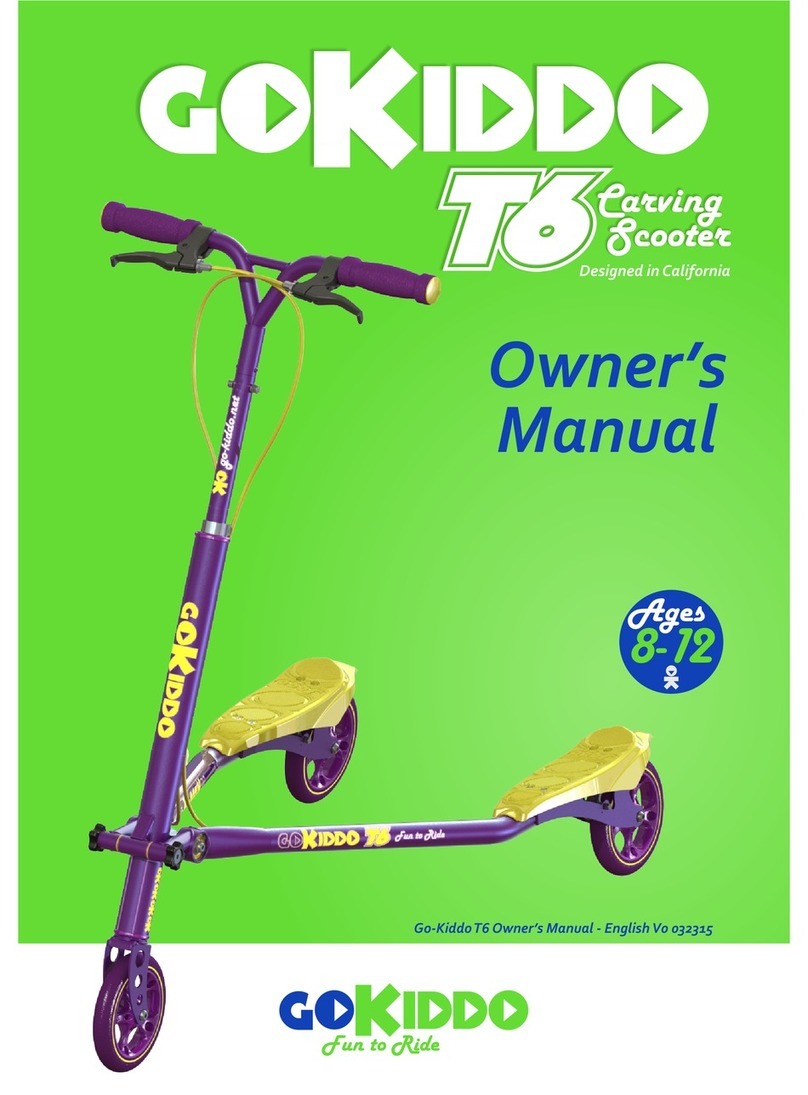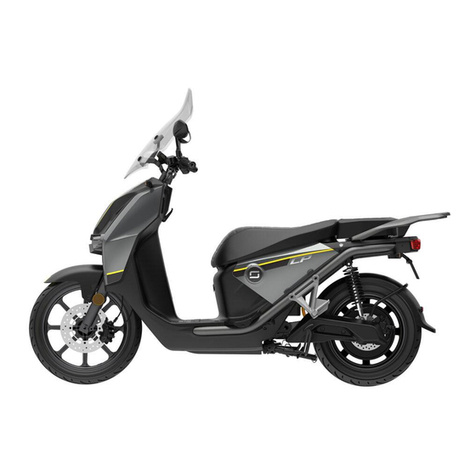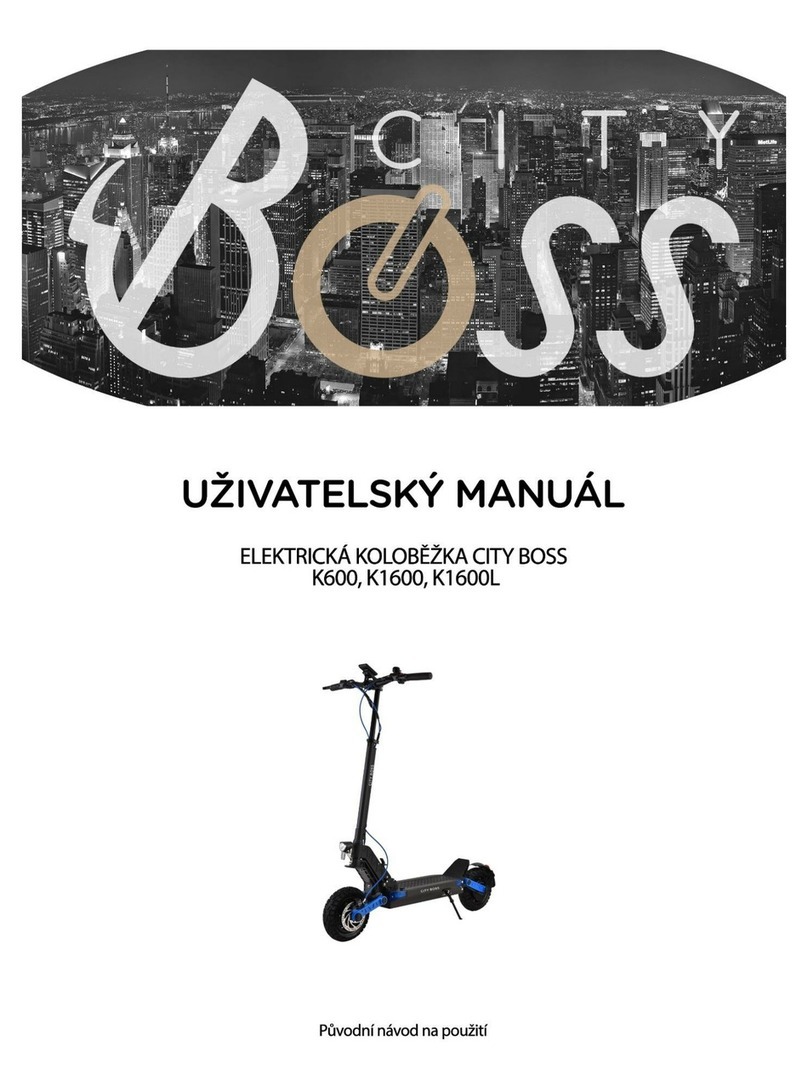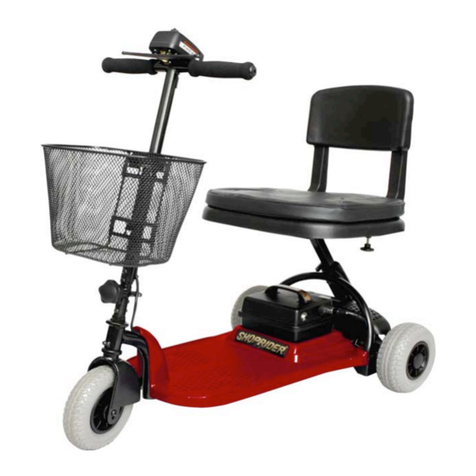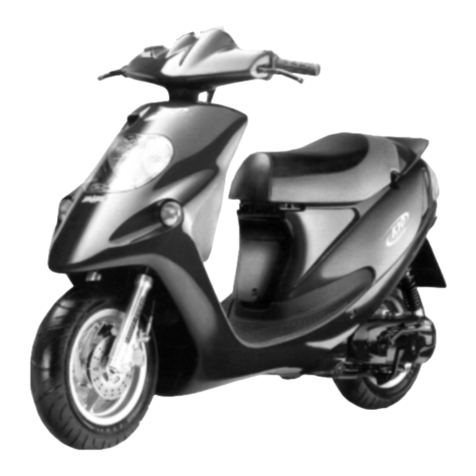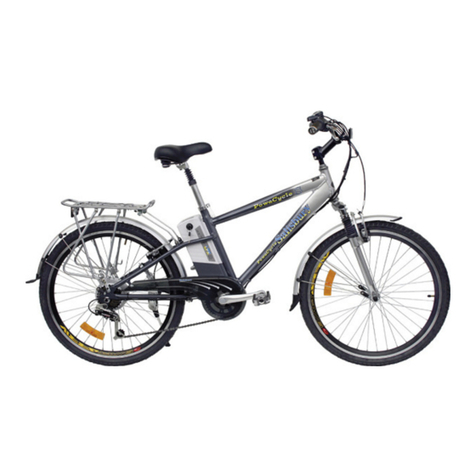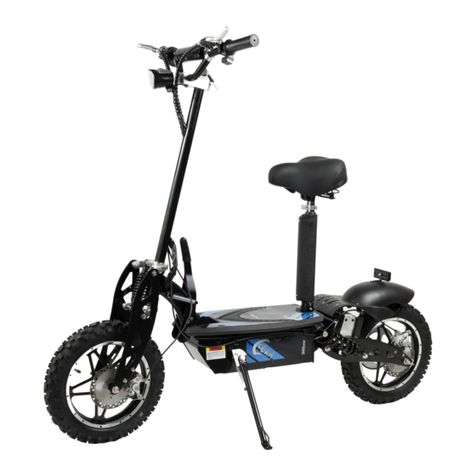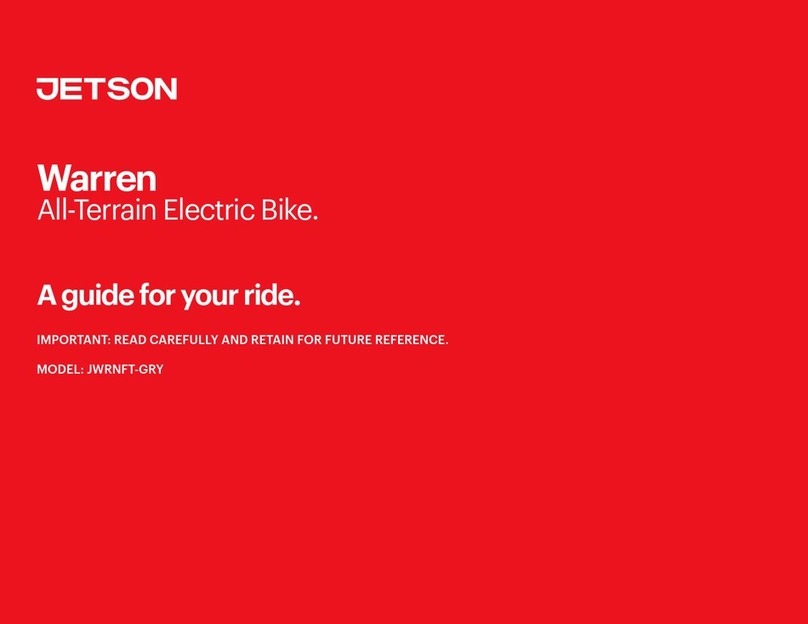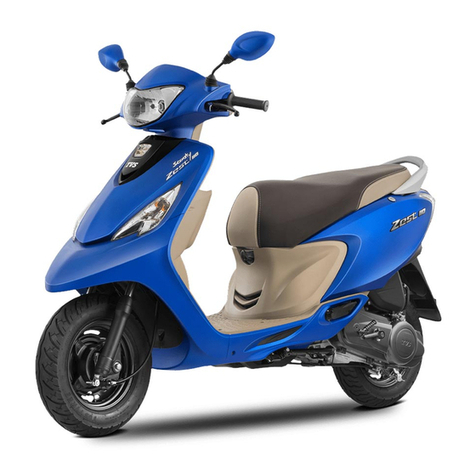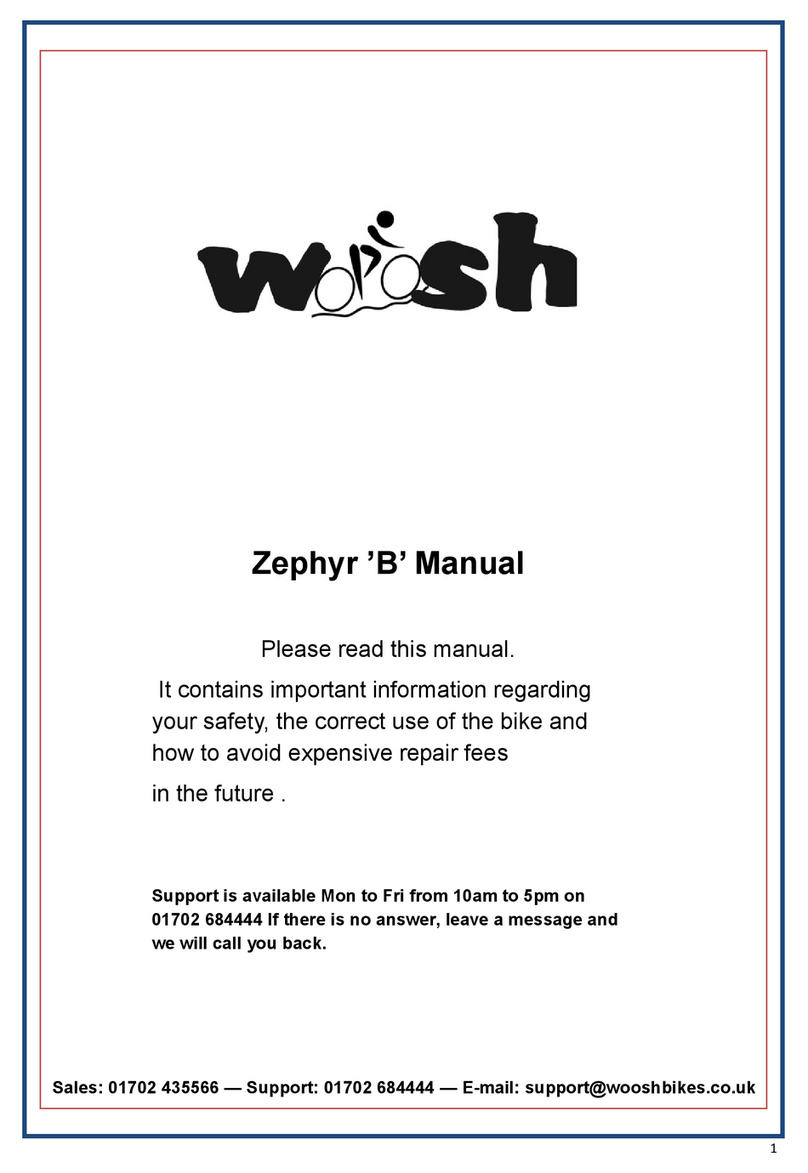Go Kiddo T7 User manual

Go Kiddo T7 Carving Scooter Owner’s Manual - V1 - 01/22/2015
Owner’s
Manual

Go Kiddo T7 Carving Scooter Owner’s Manual - V1 - 01/22/2015 - Page 02
If you have never carved down the road on one of our 3-wheeled cambering vehicles before, you
are about to have a great, new experience. You will discover an entirely new way to propel across
pavement. But you'll do it in an engaging, ergonomic, non-impactful way… that just happens to
give you a phenomenal full-body, calorie-burning, fat-shedding workout.
And. It's fun.
If it's just the thrill of the ride you're after (and you could care less about the fitness side-effects)
you will not be disappointed. After more than ten years, we are still always discovering nuance in
the ride. New combinations. New senses of flow. Arm punch-drive to handlebar pry to toe-kick
whipper. Relax. Breathe. Punch-the-bag sprint to a nice-and-easy cruise. Ahhh. We're enjoying
with more passion than ever before. Go ahead. Have a blast in a parking lot - for hours - it's
common. Take long nature rides or rediscover your neighborhood - recommended.
You'll learn all the riding subtleties with time. Going effortlessly, or going hard. The T7 is a great
place to start.
When you are ready to graduate to the next riding level, your T7 is ready to convert to a full air tire
ride – a ride that can take you smoothly into a world of more varied pavement – broadening your
carving universe…
Remember to relax as you learn. Allow your body to be active but relaxed. When learning anything
new, we believe that you will learn much quicker if you quiet the mind and let your body do what it
knows how to do best. That's not to say to go ahead and check out. You're not getting a massage
here…. Remain aware and alert and active, but relaxed. You want to get into the flow. The better
you flow, the easier and smoother you'll go. And for speed? Just add power = driving with the arms
and pumping with the legs. The more power you add, the faster you will go.
We recommend that you give a look to the instructional DVD, or go online to www.go-
kiddo.net/how-to-ride and review our videos. Watch and imitate. Let your body imitate the
flowing motion.
Thanks for taking this step with us. You're part of something new and good for you.
OWNER’S MANUAL
CONGRATULATIONS ON YOUR PURCHASE OF A
NEW Go Kiddo T7 Carving Scooter!

Go Kiddo T7 Carving Scooter Owner’s Manual - V1 - 01/22/2015 - Page 03
IMPORTANT MUST READ WARNINGS, SAFETY
INFORMATION AND RIDING TIPS
Thank you for purchasing a Go Kiddo™ product. This owner’s manual is designed to
help you make the most of your Go Kiddo Carving Scooter. Instructions and warnings have
been carefully prepared to make your experience as safe and enjoyable as possible. Use
common sense while riding and enjoy your new Go Kiddo Carving Scooter. Read additional
information on page 15.
READ AND UNDERSTAND the assembly, maintenance and safety sections of
the owner’s manual before riding. Always follow the instructions and pay attention to all
warnings.
ŸAlways wear proper safety equipment when riding the Go Kiddo Carving Scooter
including an ANSI, SNELL, CPSC, ASTM or DIN EN 1078 approved helmet. Use proper
footwear and secure laces on shoes before riding.
ŸAvoid water, bumps, gravel, sand, cracks, uneven surfaces or obstacles that may stop
you suddenly or cause you to lose control. The Go Kiddo Carving Scooter is not intended
for off-road use. Avoid riding at night.
ŸHands free riding can be dangerous. Use both hands to hold the handlebars firmly at all
times. Do not push too hard on or apply uneven pressure to either side of the
handlebars. Do not make sudden sharp turns or apply your body weight to the
handlebars when turning. Such actions may cause the vehicle to “jack-knife” or to stop
suddenly, which can cause serious injury to the rider.
ŸStunt riding, riding backwards and/or extreme riding are not recommended on the T7
Carving Scooter. Riding in this fashion may damage the product and voids the
warrranty and may result in injury or death.
ŸDo not lean back or pull back on the handlebars. Doing so can cause the rider to fall off
the back of the vehicle possibly resulting in serious injury or death.
ŸPolyurethane wheels do not perform well on wet pavement or any other wet surface.
Polyurethane loses traction on most wet surfaces, and water on the wheels can
dramatically reduce the effectiveness of the brakes. If you must ride in wet conditions be
very careful to avoid sliding out and do not carve hard turns.
ŸDownhill riding is not recommended, especially for novice riders. The Go Kiddo Riding
!

Go Kiddo T7 Carving Scooter Owner’s Manual - V1 - 01/22/2015 - Page 04
Toys is designed primarily for use on flat dry pavement. Riding on steep hills or doing
prolonged downhill rides is not recommended. Prolonged use of the brakes will
causethe rear polyurethane wheels to wear down prematurely, dramatically reducing
the effectiveness of the brakes or even causing them to fail. Extreme caution should be
used when riding on any hill.
ŸWe recommend that you do not exceed the recommended maximum rider weight limit
- Go Kiddo T7 Carving Scooter weight limit: 250 lbs (114 kg).
ŸAlways inspect the vehicle before each ride and make sure that the handlebar quick
release and the folding mechanisms are securely locked in the proper riding position.
Read the assembly section of the Owner’s Manual for important assembly and
maintenance information.
ŸTest the brakes for proper function before each ride and do not turn the handlebars
o
more than 180 . The brake cables can wrap around the steering column and possibly
engage the brakes. Make sure that your brake cables are not wrapped around the
steering column before each riding session. Always apply both brakes evenly with your
weight distributed evenly over each rear wheel.
ŸChildren should always be supervised by an adult when riding. It is the parent or
guardian’s responsibility to properly maintain and inspect the vehicle before each riding
session. The Go Kiddo Carving Scooter is not recommended for children under 7 years of
age.
ŸAlways exercise extreme caution when you are riding in proximity to other vehicles,
pedestrians, and especially in proximity to cars if you are riding on a street. Be sure to
obey all rules of the road. Please be courteous to riders of other vehicles and all
pedestrians. Share the path!
ŸDo not modify your Go Kiddo Carving Scooter. Only use Go Kiddo Riding Toys, Inc.
Approved parts or accessories. See the limited warranty for other use restrictions.

Go Kiddo T7 Carving Scooter Owner’s Manual - V1 - 01/22/2015 - Page 05
ŸIf you do not have the proper tools or find that you are unable to understand the
assembly instructions, have a qualified Go Kiddo dealer assemble the Go Kiddo Riding
Toys for you.
ŸIf a Go Kiddo dealer assembles the vehicle for you, be sure to read the Riding and Safety
sections of the owner’s manual before riding for the first time.
Ÿ Immediately stop riding if you suspect that any part of the vehicle is not functioning
properly. Inspect the vehicle closely to confirm what the problem is. Contact your dealer
or Go Kiddo Riding Toys, Inc. directly if you suspect that a malfunctioning or defective
part is affecting its safe operation.
Ÿ The front wheel is turned exactly 180 degrees to that of a bicycle. Unlike a bike, a carving
vehicle’s front wheel actually trails behind the fork. Altering this wheel position will
change the intended performance of the vehicle. See the photo on page 6 of this manual
to see the proper position of the front fork.
Ÿ Riders performing in Go Kiddo Riding Toys, Inc. produced videos and photos are highly
skilled and specially trained professionals. Do not try these tricks yourself or you may
lose control and fall causing serious injury and even death.
GENERAL WARNINGS

Go Kiddo T7 Carving Scooter Owner’s Manual - V1 - 01/22/2015 - Page 06
KNOW THE GO KIDDO CARVING SCOOTER
HANDLEBAR
STEM
STEERING
AXLE
FRONT TUBE
CAMBERING
AXLE
BRAKE
LEVER
FRONT
FORK
FRONT WHEEL
CAMBERING JOINT
REAR FORK
REAR
WHEEL
DECK
BRAKE PAD
HANDLEBAR HEIGHT
ADJUSTMENT QUICK
RELEASE
LEFT ARM
RIGHT ARM

Go Kiddo T7 Carving Scooter Owner’s Manual - V1 - 01/22/2015 - Page 07
Go Kiddo ASSEMBLY
Remove the T7 Carving Scooter from the box:
A. Left Arm (with brake cable)
B. Right Arm (with brake cable)
C. Handlebar
D. Front Structure
E. Front Fork
F. Wheels (3x)
G. Main Axle
H. Tolls
I. Manual
A
B
C
D
E
F
G
Arrange the parts
this way on the floor
or over a table.
1
H
2
Attach the arms
to the yoke.
Concave
face fowards
bushing
Allen wrench
5mm

Go Kiddo T7 Carving Scooter Owner’s Manual - V1 - 01/22/2015 - Page 08
3Insert the main axle through the 3 main frame
parts and tighten the bolts using two 5mm allen
wrench.
Allen wrench
5mm
Lock
Lock
Install the handlebar.
4
O
40
= =
Allen wrench
5mm
FRONT
FRONT

Go Kiddo T7 Carving Scooter Owner’s Manual - V1 - 01/22/2015 - Page 09
Install brake cables.
5
22. ATTACH BRAKE
CABLE END AND
SLIDE THROUGH
SLOTS.
STAY
STAY
PAY ATTENTION TO THE
PROPER CABLE ROUTING
13
3. TIGHTEN THE
ADJUSTING SCREW
AND LOCK-NUT
1. ALIGN SLOTS
TURN THE ADJUSTER
SCREW AND LOCK-NUT
UNTIL THEY MATCH
THE SLOT ON THE BODY
OF THE BRAKE LEVER.

Go Kiddo T7 Carving Scooter Owner’s Manual - V1 - 01/22/2015 - Page 10
WHEEL
SPACER
AXLE
BOLT
SPACER
Attach the wheels to the arms and front fork.
6Allen wrench
5mm
Attach the front fork to the front struture.
7Allen wrench
5mm
Align the
handlebar to the
front wheel before
tighten the 2 bolts.
FRONT BACK

Adjusting the
height of the
handlebar.
10
Go Kiddo T7 Carving Scooter Owner’s Manual - V1 - 01/22/2015 - Page 11
Adjusting the brakes.
8
PULL
3mm
allen
wrench
3 mm
(1/8")
Folding the frame.
9
Allen wrench
3mm
Allen wrench
5mm
Insert the axle
back into the
arms end.
The T7 Carving Scooter brakes
are scrub type brakes. A metal
pad is pushed straight against the
tire creating friction and stopping the
wheel.
The pad must be adjusted leaving a working
gap between the pad and tire – 3mm (1/8”).
At the pad you will find a clamp that holds the
brake cable. Loosen the bolts, slide and stretch the
cable, and re-tighten the bolts to adjust the brake.
You may place any spacer of 3mm (1/8”) in between the pad and tire while performing
the adjustment and cable stretch. It's recommended the use a pair of pliers to pull and
stretch the cable.
The brake should work efficiently at a half way squeeze of the brake lever at the
handlebar.
OPEN/
CLOSE
PUSH
Adjust
clamping
tension by
tightening
the nut.

Go Kiddo T7 Carving Scooter Owner’s Manual - V1 - 01/22/2015 - Page 12
FINAL ASSEMBLY CHECK LIST
1. When you think that you have completed the assembly process, study the
vehicle one more time and compare it to the photograph on page 6.
2. Check the bolts that secure the front fork and handlebars. A good push and
pull on the handlebars will immediately indicate whether or not the stem
plate is properly secured. The handlebars should not be able to rotate on the
stem - even with all of your weight pushing on it.
3. Do a final brake check by spinning both rear wheels. They should spin
freely until you apply the brakes. You should be able to vigorously squeeze the
brake levers without the levers depressing all the way to the handlebar.
4. Always check all of the bolts before riding to insure that the vehicle and all
of its components are operating properly.
For any questions regarding your Go Kiddo replacement parts or accessories,
please go to the www.Go Kiddo.com website for further details.
ASSEMBLY QUESTIONS OR REPLACEMENT PARTS
BEFORE RIDING FOR THE FIRST TIME, PLEASE TAKE SEVERAL MINUTES TO GO
OVER THE IMPORTANT RIDING AND SAFETY TIPS ON PAGE 3 AND 4 OF THIS
MANUAL.
FOR THE SAFETY OF FRIENDS AND OTHERS WHO WILL TRY YOUR NEW Go
Kiddo PRODUCT, IT’S YOUR RESPONSIBILITY TO COACH THEM ABOUT SAFE
RIDING. MAKE SURE THEY READ AND UNDERSTAND ALL WARNINGS AND
SAFETY INFORMATION IN THIS OWNER’S MANUAL BEFORE RIDING.
CAUTION !

Go Kiddo T7 Carving Scooter Owner’s Manual - V1 - 01/22/2015 - Page 13
THE PNEUMATIC TIRES ON T7 CARVING SCOOTER
The air tires come with lower pressure from the
factory for transportation reasons. You will need to
adjust the tire pressure according to the rider’s
weight and riding preferences. Please do not exceed
80 psi (5,6 bar) maximum inflation. See examples
down:
RIDER’S WEIGHT
170lbs (77kg)
250lbs (114kg)
TIRES PRESSURE
REAR TIRESFRONT TIRE
73 psi (5.1 bar)
80 psi (5.6 bar)
77 psi (5.4 bar)
80 psi (5.6 bar)
T78 Air model, with 3 pneumatic tires.
T78 cs model, T78 cs model,
with 1 front with 1 front
pneumatic tire,pneumatic tire,
and 2 rear and 2 rear
polyurethane polyurethane
wheels.wheels.
T78 cs model,
with 1 front
pneumatic tire,
and 2 rear
polyurethane
wheels.
TIRE PRESSURE AFFECTS THE RIDING PERFORMANCE:
Lower pressure makes for a smooth but slower ride, higher pressure makes for a faster but
slightly bumpier ride. Check tire pressurre once a week - use a tire gauge. Do not ride with
low pressure as this can damage the tires and pose more risk of falling.
CONVERTING YOUR
T7 TO ALL AIR RIDE:
You can easily convert your T7C to
an All Air Ride. T8 Air wheel sets are
avilable at www.Go Kiddo.com.
HOW TO INSTALL AIR WHEELS
USE SHORTER
SPACER SUPPLIED
WITH AIR WHEEL
13mm (2x)
2. MOVE THE BRAKE PAD
1. UNINSTALL T7 PU WHEELS
3. INSTALL AIR WHEEL
Allen wrench
5mm
(DISCARD ORIGINAL
LONGER SPACER)

Go Kiddo T7 Carving Scooter Owner’s Manual - V1 - 01/22/2015 - Page 14
Now that you have successfully assembled your new Go Kiddo™
carving vehicle, we will take you through some simple riding tips
to help you get started. We always recommend that you ride
with a helmet and safety gear. Pay special attention to where
you are riding, your proximity to other people, and especially
your proximity to cars if you are learning to ride on a street
or in a parking lot. Please exercise repectful path etiquette
where other riders and pedestrians are onthe same path.
Athletes who are accustomed to skiing or inline
skating typically pick it up in a matter of minutes.
Don’t be discouraged if you can’t climb on and
speed away at 15 miles per hour. Being an entirely
new vehicle, it requires some new skills.
Regardless of your athletic background, you can
learn to ride a Go Kiddo carving vehicle in a
relatively short period of time - usually in less
than an hour.
GO KIDDO RIDING MANUAL
THE GREATEST WORDS OF WISDOM ARE:
“Keep going until you feel the sweet spot.”
Please note: If friends or family are riding for the first time, for their safety please take
the time to properly instruct them and have them wear safety equipment.
You are now embarking on a totally new experience. Not often does a new Riding
Technology emerges to change our way of thinking about motion and its application.
Conservation of angular momentum is the physical principle that the Go Kiddo Carving
Scooter harnesses in order to transfer the rider’s energy into forward momentum.
It is the painstaking research and development by Go Kiddo Riding Toys over a period of
12 years that has optimized the melding of this principle with a human powered vehicle.
The exclusive 3CV™ Riding Technology developed by Go Kiddo Riding Toys is the
mechanism that makes this forward propulsion possible. The unique carving mechanism
is elegantly simple yet provides the necessary rigidity, geometry and resistance to the
rider’s motion to allow for optimum control, speed, comfort, durability and especially
rider confidence. You are now the owner of the original Go Kiddo Riding Toys.

Go Kiddo T7 Carving Scooter Owner’s Manual - V1 - 01/22/2015 - Page 15
SAFETY ISSUE #1: RIDING IN WET CONDITIONS
THE FOLLOWING FIVE WARNINGS HAVE BEEN SELECTED FROM THE LIST AT THE
BEGINNING OF THIS MANUAL FOR MORE IN DEPTH DESCRIPTION AND INSTRUCTION.
PLEASE READ AND UNDERSTAND THESE AND ALL WARNINGS BEFORE RIDING.
Because Go Kiddo™ carving vehicles use hard polyurethane wheels, we want to warn you
about the potential hazards of riding on wet pavement. Just like inline skates or skateboard
wheels, Go Kiddo wheels become very slick when wet, and the vehicle can come right out
from under you if you are not very careful how you are carving turns in wet conditions. If it’s
raining or the pavement is wet from dew or drizzle we do not recommend that you ride
without extreme caution and awareness of the potential for sliding out. If you encounter a
puddle or a wet place in the pavement that you cannot avoid, you may want to walk the
vehicle until you are on dry pavement again. If you fi nd yourself on wet pavement at any
time while riding, you may want to coast straight through the wet area without turning.
When you reach dry pavement, give the wheels a few rotations to dry off before you to any
turns. Experienced riders may ride on wet surfaces because they understand they might
slide out any time and they are ready for it.
SAFETY ISSUES
SAFETY ISSUE #2: WEIGHT DISTRIBUITION
Since you are essentially standing directly above the rear wheels, it is quite easy to go over
backwards by leaning back. Be careful to not lean back or distribute your body weight
behind the rear wheels. This warning is especially important for riders with restricted
movement, or reaction time. Great care should be taken to avoid getting into a situation in
which you have to quickly dismount the vehicle. If you are standing still on the vehicle it is
always recommended that you keep the brakes on. If for some reason you feel yourself going
off the back, putting the brakes on will help stop the vehicle from scooting out from under
you, but you should always step off as a precaution.
The best way to insure that you are always positioned properly on the vehicle and to
minimize the potential for going off the back is to distribute your weight evenly between the
front and rear wheels. Accordingly, you should not lean forward over or onto the handlebars
either but rather move your toes up to the front of the foot platforms and always let the balls
of your feet and toes carry most of your weight. Avoid rocking back on your heels, pulling
back on the handlebars or sticking your butt out behind the rear wheels. If you put too much
of your body weight over the rear wheels or behind them (in the case of sticking your butt
out) you will inevitably un-weight the front wheel. Besides the risk of going off the back, the
other reason for evenly distributing your weight is to insure that your front wheel has plenty
of traction, which leads us to the next safety issue.

Go Kiddo T7 Carving Scooter Owner’s Manual - V1 - 01/22/2015 - Page 16
SAFETY ISSUE #3: HANDLEBAR ETIQUETTE
Properly managing the handlebars and especially how far to the left and right you turn them
while you are riding is vital to your safety. Because the front wheel has been designed to trail
the fork, the handlebars have a tendency to turn on their own in the direction that you are
leaning the vehicle. Unlike a bicycle, which wants to go in a straight line, the front wheel will
actually accentuate a turn. Because of this condition, new riders need to pay special
attention to not over steer. Over steering can cause the handlebars to cross up or “jack knife”
which will stop the vehicle suddenly and possibly cause an injury. Always maintain fi rm
control of the handlebars with both hands and never ride with one or no hands. The Go
Kiddo carving vehicle requires both hands on the handlebars at all times.
First time riders have a tendency to muscle the handlebars and throw their weight from
side to side. What propels the Go Kiddo carving vehicle forward is a combination of turning
and leaning the steering column, not jerking or thrusting the handlebars from side to side.
It is best to think in terms of more rocking and less turning. Long smooth turns are best
for beginners.
Because the handlebars are free to spin 360ْ it is possible for the brake cables to get twisted
around the steering column. If you try to ride with the cables twisted the vehicle will
probably feel sluggish because one of the brakes is probably partially engaged. Before
riding, always check to see that the brake cables are not wrapped around the steering
column.
SAFETY ISSUE #4: RIDING DOWNHILL
Because the Go Kiddo carving vehicle is a totally new machine with completely foreign riding
characteristics, we strongly recommend that you take your time when familiarizing yourself
with the vehicle and gradually test the performance boundaries of its riding characteristics.
This is especially important before attempting to ride up or down hills. Both hill climbing and
downhill riding are advanced and require that you become a strong competent rider before
even attempting hills --- up or down. As far as downhill riding is concerned, we strongly
recommend that you only ride down hills in which you can control your speed with turns as
you traverse the hill. Riding hills at speeds that require constant braking is not
recommended for three reasons: you can get up to speeds where your braking distances are
too long to stop you safely, you can fall causing serious injury or death, and you will quite
simply wear down your brake pads and rear wheels long before their expected functional
life expectancy.
The Go Kiddo carving vehicle will accelerate quickly down even the mildest grades, so only
ride at speeds and in an environment that are suitable for your skill level.

Go Kiddo T7 Carving Scooter Owner’s Manual - V1 - 01/22/2015 - Page 17
SAFETY ISSUE #5:
SAFETY EQUIPMENT
Always wear safety equipment,
especially a helmet. A helmet is a must
when riding a Go Kiddo carving vehicle
or any wheeled vehicle for that matter.
We also recommend that you wear
elbow and knee pads (especially for
children and inexperienced riders). As
stable a platform as the vehicle is, there
are always environmental conditions
that might catch you by surprise like
cracks in the pavement or other
READ AND UNDERSTAND THE
ASSEMBLY, MAINTENANCE AND
SAFETY SECTIONS OF THE OWNER’S
MANUAL BEFORE RIDING. ALWAYS
FOLLOW THE INSTRUCTIONS
AND PAY ATTENTION TO ALL
WARNINGS.
Visit our website at www.go-kiddo.net if you want to purchase a helmet, knee and
elbow pads.

Go Kiddo T7 Carving Scooter Owner’s Manual - V1 - 01/22/2015 - Page 18
STEP 1: MOUNT THE Go Kiddo
STEP 2: ROCK THE Go Kiddo
We recommend that you push off a few times like a scooter and simply ride around for a
few minutes to get used to the feel. It is especially important to establish a good riding
position that properly balances your weight between the front and rear wheels. First
time riders have a tendency to pop unnecessary wheelies. This can be dangerous
because you can fall back and injure yourself. Scooting your toes to the front of the
platforms and riding on the balls of your feet will help to distribute your weight to the
front wheel. Also, properly set, the handlebar height should force you to lean a bit
forward. This riding posture will give you much better stability, control, and quick braking
response. Never lean back or pull back on the handlebars.
You can actually start moving without touching your feet to the ground by rapidly turning
the front wheel back and forth. You will begin to pickup speed but will peak at only a few
miles an hour. Here is where it all comes together!
You are now turning the wheel back and forth to generate forward motion and
establishing a rhythm. No matter how bad you might be as a dancer, the Go Kiddo
experience is very rhythmic in movement and timing. Stick with it. You’ll get it. The
beauty of what drives the Go Kiddo carving vehicle’s design forward is the addition of
one final ingredient:
ROCKING THE STEERING COLUMN LEFT AND RIGHT AS YOU TURN THE WHEEL LEFT AND
RIGHT. A LEFT HAND TURN GETS A LEFT HAND ROCK.
First, find some smooth, flat and open terrain to ride on.
Parking lots, basketball courts or tennis courts are perfect
places to learn. It is best to spend plenty of time riding on
flat ground before attempting hills - up or down, and do not
assume that you already know how to ride a carving
vehicle. Even though it has familiar features like handlebars
and hand brakes, carving vehicles have unique riding and
balance characteristics that require a familiarization period.
The vehicle is easy to stand on. We recommend that you
step up onto the vehicle and spend a few minutes getting
used to the riding position, the braking system, and
HOW TO RIDE
especially the range with which you can rock the steering column left and right. This is
especially important because it is exactly this rocking capability that propels the vehicle
forward. Get used to letting your arms do the rocking --- not your body.

Go Kiddo T7 Carving Scooter Owner’s Manual - V1 - 01/22/2015 - Page 19
1
2 3 4
When you add the rock to the roll you are essentially putting the rear wheels in a subtle
yet responsive position to generate forward thrust. It will take a few minutes to catch on
to a coordinated combination of turning and rocking, but to those who have any skiing
or inline skating experience you will immediately feel the similarities.
Your speed should pickup dramatically, and you will begin to thrust forward with each
turn. Please note that it does not require that you make tight turns. Rather, you should
allow the vehicle to kind of steer itself in a more graceful curving path.
Many first time riders tend to exaggerate the turning of the handlebars thinking that they
need to continue with tight turns. Not so! The
degree of your turns should diminish as you begin
to add the rocking motion and as your speed
increases. Turning too hard can cause the vehicle
to “Jack-Knife” potentially causing you to fall. Take
your time.
Whatever you do, do not muscle the handlebars.
Experienced riders use a light touch on the
handlebars mostly for balance.
STEP 3: WEIGHT TRANSFER
By this time you have dramatically increased your speed and should be getting to know
where the sweet spot is. When we say “sweet spot,” we mean the part of your turn
where most of your propulsion is generated. Typically, you will feel the outside wheel
(your left rear wheel during a right hand turn) drift away from you as you rock the vehicle
to the right. If you apply a little weight or a kick to that left foot as you turn you will
accelerate even more. A seasoned rider can actually propel the vehicle up to 18 miles

Go Kiddo T7 Carving Scooter Owner’s Manual - V1 - 01/22/2015 - Page 20
STEP 4: HILL CLIMBING
Don’t be afraid to tackle hills, but make a point of graduating to steeper and steeper
climbs as your riding skills increase. We always say to new riders that hill climbing is an
acquired skill. You can try it, but you’ll probably frustrate yourself more than anything if
you don’t first learn and master the basic skills of riding on flat ground. The Go Kiddo™
Carving Scooter does slow down dramatically as you begin to climb a hill, requiring a new
and physically challenging Riding Technique to be added to your growing Go Kiddo
repertoire.
Hill climbs require much more upper body finesse --- especially on steep grades. If you
are riding in an area that has unavoidable hills, we recommend climbing as much as you
can just to challenge yourself and then just walk or run it to the top.
Hill climbing really brings you full circle as you actually diminish the rocking and increase
the tightness of your turns as the steepness of the hill’s grade increases. It becomes
almost like a series of rapid punching motions to force the front wheel around in order to
gain a few more feet of pavement.
Whatever you do, take your time to graduate to steeper and steeper hills. In the end, the
most challenging of hill climbs will be attainable giving you a full body workout rarely
found in any other sport…if any at all.
STEP 5: DOWNHILL
Please read the Safety Issue #4 on page 16 of this manual. It best describes our
recommendations about riding downhill.
per hour or better on flat ground…which is really moving.
The combination of these Riding Techniques will be new to you for sure, but be assured
that riding time will help you to create a smooth and beautifully coordinated movement.
You will be able to travel for miles with long graceful strides and rapid sprints. The
beauty of it is that you will always be looking ahead for places to carve and to add the
skiing dimension to what would have been a straight line ride on any other vehicle.
STEP 6: PROPER BRAKING RIDING TECHNIQUE
Because the Carving Scooter has brakes on both rear wheels, it is important to learn how
to optimize their effectiveness with some simple rules. First, always apply both brakes
together and evenly. Second, dispersing your weight evenly to each rear wheel is crucial
for maximum braking effectiveness. If you lift your weight from one foot platform while
braking you will cause that wheel to lose traction with the ground. Finally, do not lean on
the handlebars while braking.
Table of contents
Other Go Kiddo Scooter manuals
